Optical Mammography for Breast Cancer: Future Diagnostic and Treatment Tool?
A new imaging method--optical imaging mammography--is being developed as a tool that aims to provide a better way to identify breast cancer and to monitor patients’ responses to localized treatment.
Optical imaging mammography is being developed as a multidisciplinary collaboration at Tufts University School of Engineering in Boston. The tool aims to provide a better way to identify breast cancer and to monitor breast cancer patients’ responses to localized treatment.
Researchers involved in the development believe optical mammography will complement standard x-ray mammography especially for women younger than 40 years of age who have particularly dense breast tissue that cannot be analyzed well with x-ray mammograms. The US Food and Drug Administration recently approved a different method, an ultrasound imaging device, for detecting tumors in dense breast tissue.

Image of optimal mammography in breast cancer patient; source: Tufts University
Tufts is starting a 5-year clinical trial to test the new diagnostic in women for whom breast cancer screening is recommended. The trial will test the technique in healthy women and those with benign breast lesions to examine how effective optical mammography is in detecting breast cancer and differentiating between benign and malignant tumors. A second part of the study will examine breast cancer patients who are being treated with chemotherapy to test for measurable responses. The study is funded by the National Institutes of Health. The development is currently a fully academic development.
Optical mammography is not a new technique-other studies in the United States and internationally are ongoing. The new clinical trial will focus on “a quantitative approach to optical imaging as a stand-alone technique for painless, noninvasive, and safe detection/monitoring of breast cancer,” said Sergio Fantini, PhD, professor of biomedical engineering at Tufts and leader of the research effort.
How is optical mammography different from traditional x-ray mammograms? Optical mammography is comparatively more comfortable with much less breast compression compared to x-rays. From a technical standpoint, the main difference between these two techniques is in the “source of contrast,” said Fantini. For optical mammography, the contrast comes from blood concentration, blood oxygenation, water, and lipids; for x-ray mammography the source is tissue density. “From a practical perspective, the appeal of optical mammography is that it does not use ionizing radiation, and it does not require strong breast compression.”
Optical mammography can complement rather than replace x-ray mammography, according to Fantini and collaborators Roger Graham, MD, director of Tufts Medical Center's Breast Health Center, and Marc Homer, MD, chief of mammography at Tufts Medical Center. The technique can also be applied to cases where x-ray mammography is not applicable such as to image younger women and to monitor response to therapy. X-ray mammography can detect lesions well, but the technique does not differentiate between cancerous and noncancerous abnormalities, according to Fantini.
“This pilot clinical trial aims at demonstrating the potential of optical mammography in discriminating benign and malignant breast lesions,” said Fantini. The trial will test whether optical mammography information can reinforce x-ray data in patients who have suspicious breast lesions. The initial results of the study were published 2 years ago in the Journal of Innovative Optical Health Sciences.
Optical mammography uses near infrared light to scan breast tissue, then applies an algorithm to interpret the image and information. The technique can measure differences in water and fats. The tool creates real-time images of metabolic changes, allowing the differentiation between oxygen-rich and oxygen-poor tissue and varying levels of hemoglobin through differences in light absorption. Unlike standard x-ray mammograms there is no ionizing radiation involved, allowing technicians to apply the technique several times without the risk of radiation exposure.
“There is a high acceptance of the technology from patients, mostly because of the lack of breast compression and the lack of ionizing radiation,” said Drs. Fantini, Homer, and Graham. “The information content of the optical mammograms is very different than that of x-ray mammograms, and it takes this kind of pilot clinical trials for a radiologist to identify the diagnostic capability of optical mammography and the keys to interpreting the optical images,” said the researchers.
The researchers emphasize that optical mammography must still demonstrate a high level of sensitivity and specificity in order to be a robust screening modality. It will take several years before results of the trial will demonstrate the full clinical potential of optical mammography.
Newsletter
Stay up to date on recent advances in the multidisciplinary approach to cancer.